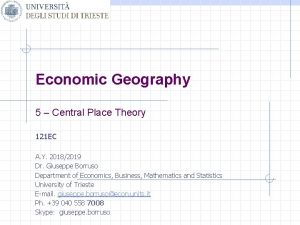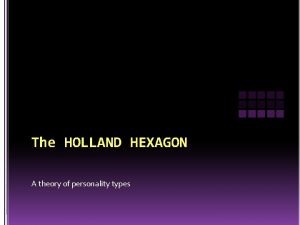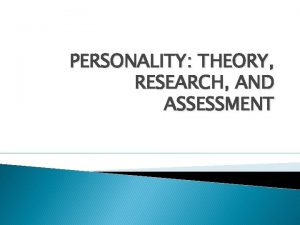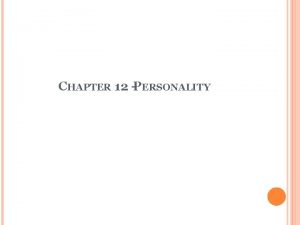The HOLLAND HEXAGON A theory of personality types
















- Slides: 16

The HOLLAND HEXAGON A theory of personality types

According to John Holland's theory, most people are one of six personality types: realistic, investigative, artistic, social, enterprising, and conventional. The characteristics of each of these are described in the following presentation.

The Types

Enjoys working with animals, tools, or machines Generally avoids social activities such as teaching, healing, and informing others Is skillful when working with tools, mechanical or electrical drawings, machines, or plants and animals Values practical things you can see, touch, and use, such as plants and animals, tools, equipment, or machines Sees self as practical, mechanical, and realistic

Enjoys studying and solving math or science problems Generally avoids leading, selling, or persuading people Is good at understanding and solving science and math problems Values science Sees self as precise, scientific, and intellectual

Enjoys creative activities such as art, drama, crafts, dance, music, or creative writing Generally avoids highly ordered or repetitive activities Has good artistic abilities in creative writing, drama, crafts, music, or art Values creative arts such as drama, music, art, or the works of creative writers Sees self as expressive, original, and independent

Enjoys doing things to help people such as teaching, nursing, giving first aid, or providing information Generally avoids using machines, tools, or animals to achieve a goal Is good at teaching, counseling, nursing, or giving information Values helping people and solving social problems Sees self as helpful, friendly, and trustworthy

Enjoys leading and persuading people, and selling products and ideas Generally avoids activities that require careful observation and scientific, analytical thinking Is good at leading people and selling things or ideas Values success in politics, leadership, or business Sees self as energetic, ambitious, and sociable

Enjoys working with numbers, records, or machines in a set, orderly way Generally avoids ambiguous, unstructured activities Is good at working with written records and numbers in a systematic, orderly way Values success in business Sees self as orderly, and good at following a set plan

THE THEORY

Holland's theory can be summarized in six statements:

1. In our culture, most persons are one of six personality types: realistic, investigative, artistic, social, enterprising, and conventional. 2. People of the same personality tend to flock together. For example, artistic people easily make friends with and work well with other artistic people.

3. When people of the same personality type work together, they create an environment that fits their type. For example, when artistic persons are together on a job, they create a work environment that rewards creative thinking and behavior — an artistic environment. 4. There are six basic types of work environments: realistic, investigative, artistic, social, enterprising, and conventional.

5. People who choose to work in an environment similar to their personality type are more likely to be successful and satisfied with their jobs: For example, artistic persons are more likely to be successful and satisfied if they choose a job that has an artistic environment, such as choosing to be a dance teacher in a dancing school, an environment dominated by artistic people where creative abilities and expression are highly valued.

6. The way you act and feel at work depends, to a large extent, on your workplace environment. If you are working with people who have a personality type like yours, you will enjoy many of the things they enjoy, you will feel comfortable with them, and your skills will be in the same areas. This combination creates a productive and satisfying environment.

 Hexagon holland
Hexagon holland Holland's theory
Holland's theory August lösch
August lösch Hát kết hợp bộ gõ cơ thể
Hát kết hợp bộ gõ cơ thể Bổ thể
Bổ thể Tỉ lệ cơ thể trẻ em
Tỉ lệ cơ thể trẻ em Chó sói
Chó sói Tư thế worms-breton
Tư thế worms-breton Chúa sống lại
Chúa sống lại Môn thể thao bắt đầu bằng từ đua
Môn thể thao bắt đầu bằng từ đua Thế nào là hệ số cao nhất
Thế nào là hệ số cao nhất Các châu lục và đại dương trên thế giới
Các châu lục và đại dương trên thế giới Cong thức tính động năng
Cong thức tính động năng Trời xanh đây là của chúng ta thể thơ
Trời xanh đây là của chúng ta thể thơ Cách giải mật thư tọa độ
Cách giải mật thư tọa độ Phép trừ bù
Phép trừ bù






























